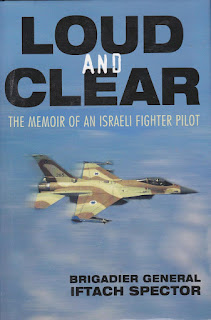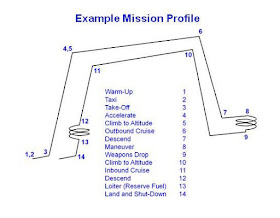A study published this past April by the
Center for Strategic and Budgetary Assessments raises some important questions about what the future of air combat, and air dominance holds in store. The study projects forward to make recommendations for the next ten to fifteen years of defense spending, based around past and current trends. Among the conclusions drawn by this study, and certainly the one that will draw the most attention, is the assertion that:
"An effective sixth-generation 'fighter' may look similar to a future 'bomber' and may even be a modified version of a bomber airframe or the same aircraft."
In other words, the study is suggesting that in the future, air combat maneuverability will become less important, and that a future fighter will need to carry lots of weapons and travel over long distances.
The CSBA study highlights a number of trends in air combat from the past half century, which bear repeating:
- The key role of situational awareness
- The transition from guns-only to missile-dominated engagements
- The integration of hostile IFF (identify friend-or-foe) interrogation systems
- The increasing role of AWACS in battlefield management
- The emergence of infrared search and track systems (IRSTS)
The study also takes note of the growing concern surrounding the United States' force projection capabilities in the Far East, where there are relatively few friendly air bases and where the distances are much greater.
 |
| Proposed CSBA model for future air dominance (CSBA Graphic) |
What the study proposes as a solution to this scenario, is a new air dominance model: one which relies on a combination of bomber-sized command and control centers and unmanned air vehicles. It is assumed that both the command and control aircraft and the UAVs would be low-observable aircraft, and that they would be armed with beyond visual range missiles. The study further suggests that in a future stealth-on-stealth engagement, where the opposing aircraft would likewise have some measure of low observable capability, that the principle sensor for detecting, tracking and firing upon an opponent would become infrared search and track systems (IRSTS).
Unfortunately there were a number of gaps in the data set from which the CSBA study drew its conclusions. The study does not differentiate between BVR missile kills that were launched from beyond visual range, and those that were launched from within visual range. In other words, just because it was a radar-guided missile that made the kill, that could have been launched from beyond visual range, does not necessarily mean that it was launched from beyond visual range. The study also accepts at face value the air-to-air kill claims made during the Iran-Iraq war of the 1980s - failing to take into account the vast cultural differences in combat reporting between the West and the Middle East. This is equivalent to accepting the reports of "Baghdad Bob" during the 2003 Iraq War as if they were gospel.
 |
Fiberglass mockup hailed as a "fighter" by Iranian
authorities in 2013 (Mashregh News) |
The study takes at face value some 290 air-to-air kills from the Iran-Iraq war of the 1980s. To put that into perspective, that's more than all of the other air-to-air kills, from all other air wars, in the 1980s, 90s, and 2000s - combined. The study further credits the Iranian air force with "sixty-two kills by F-14 crews using AIM-54 Phoenix missiles." These claims fly in the face of assessments from the U.S. Central Intelligence Agency which maintain that shortages in spare parts and coolant had rendered most of Iran's air-to-air missiles inoperative. The CIA also reported that only three Iranian F-14 Tomcat pilots had actually completed the entire F-14 training syllabus prior to the outbreak of the Revolution, and further confirmed that Iraqi fighters were able to carry out repeated attacks on Iranian-bound oil tankers with no appreciable losses throughout the war.
Again, there is a fundamental difference in the accepted norms for reporting between Middle Eastern nations and the West. It's akin to the fiberglass mock-up that was hailed as a "fighter" by Iranian authorities in 2013. None of the official air-to-air kill claims made during the Iran-Iraq war can therefore be taken at face value.
There is credible data available regarding the air-to-air kills that are confirmed to have been made. That data was assembled into a study for the U.S. Air Force by Col. James Burton in 1986, covering the period from 1960 to 1986. That study confirmed the transition from a guns-only to a missile-dominated environment. However, out of 2,014 air-to-air missile launches, and 407 successful missile kills, only four air-to-air victories could be credited to missiles launched from beyond visual range.
The reasons for this are closely tied to rules of engagement, and the requirements needed to prevent fratricide. It's not enough to know that another aircraft does not respond to a friendly IFF signal. You have to verify what that aircraft is before you are authorized to fire upon it.
The other credible, publicly available air combat data comes from the 1991 Gulf War. This war marked a turning point in the use of beyond visual range air-to-air weapons. This was the first war where the United States possessed aircraft - in the form of the F-15 Eagle - with the necessary hostile IFF capabilities to independently verify the identity of an opposing aircraft. During the Gulf War, 16 out of 38 allied kills were made from beyond visual range - an unprecedented total. That amounted to 42% of all allied kills. However, this also meant that 58% of the kills were still made from within visual range.
The air dominance proposal presented by the CSBA report therefore has a number of gaps. The proposal relies exclusively on beyond visual range intercept capabilities, which from the historical data, can be expected to fail the majority of the time. The proposal also relies on infrared sensors to obtain a BVR intercept capability. However, all of our existing BVR weapons are radar guided. There is therefore no explanation as to how an LO-capable opponent would be engaged from beyond visual range without development of a new class of missile.
The proposal also relies on a fleet of unmanned interceptors. So the underlying assumption is that the development and procurement cost for a manned bomber fleet, that would double as a command and control center, and for an unmanned combat air vehicle to accompany them, would be cheaper than the cost for developing a manned interceptor. However, in order to have sufficient range to be useful, these unmanned aircraft would have to be as large as a long-range manned fighter. From our Global Hawk experience, we know that there is no automatic cost reduction from the deployment of an unmanned air vehicle.
 |
| Northrop-Grumman Global Hawk (USAF) |
Global Hawk was the first time that an unmanned aircraft was developed that was similar in size and role to conventional, manned aircraft. All of the prior unmanned platforms were inexpensive largely because they were piston powered, and relatively short on range, speed, and payload. The eventual acquisition cost for the Global Hawk came out to be 76% higher than was initially projected. The U.S. Air Force would cut its Global Hawk procurement from 63 to 45 aircraft, and would actually mothball all of the Block 30 versions of the aircraft, as being more expensive to operate and less capable than the manned U-2 aircraft that they were intended to replace. This confirms what prior cost models for aircraft development and procurement had already told us. The principal contributors to aircraft cost are: empty weight, maximum speed, and the quantity produced. For equivalent range, payload and cruise speed, the cost will be the same, whether manned or unmanned.
The key assumption of the CSBA study is that the vast majority of future air engagements will occur beyond visual range, with the study further pointing out that only 38% of the visual range engagements that did occur during the 1991 Gulf War involved "significant air combat maneuvering." The study fails, however, to assess what attributes lead to a high kill probability for either a beyond visual range, or non-maneuvering within visual range engagement.
Studies into the dynamics of air combat do exist, however. Most of the research in this field is no doubt classified, under contract to the U.S. or other air forces. A number of pivotal studies were nonetheless publicly released in the early 1980s by Wolfgang Herbst - then director of advanced design at MBB (Messerschmitt-Bolkow-Blohm), the forerunner to Deutsche Aerospace and which today forms the German partner under the Eurofighter Typhoon. Herbst's study assessed alternative attributes for future fighter concepts employing West German Luftwaffe pilots in simulated engagements. These studies concluded that BVR combat was "characterized by very careful power management," as each aircraft maneuvered to bring their opponent within the kill envelope of its own weapons, while avoiding exposure to the lethal envelope of the opposing aircraft. Of the projected future technologies explored, supercruise was identified as having the highest impact to the successful outcome of BVR engagements, with a kill-to-loss ratio of up to 8:1. In essence, the study concluded that the aircraft with the advantage in excess energy would the aircraft that controlled the engagement - an outcome very similar to decades of experience with close-combat maneuvering engagements.
In conclusion, the CSBA study raises significant issues. The future of U.S. air dominance is a vitally important subject that needs to be debated - both for budgetary reasons and for the sake of U.S. national security. However, the CSBA study was also based on faulty data. The majority of historical air-to-air kills, even in the 1991 Gulf War where the U.S. brought to bear all of the modern tools of airborne warning and command as well as hostile IFF interrogation, have occurred within visual range. A strategy based exclusively on a beyond visual range intercept will fail the majority of the time. The strategy proposed by the study also relies on a fleet of unmanned air vehicles, without taking into account the cost of developing such a system. Further, the study also assumes a beyond visual range stealth-on-stealth intercept capability, without highlighting the need to develop a new class of missiles to make these intercepts possible. Finally, studies into air combat dynamics have suggested that, even from beyond visual range, the advantage resides with the platform possessing superior excess energy. This conclusion is fundamentally no different from decades of visual range air combat experience.
References:
Burton, James.
Letting Combat Results Shape the Next Air-to-Air Missile. Washington DC: U.S. Department of Defense, 1986.
Burton, James.
The Pentagon Wars: Reformers Challenge the Old Guard. Annapolis, MD: Naval Institute Press,1993.
Cohen, Eliot A., ed. Gulf War Air Power Survey, Volume II, Part II: Effects and Effectiveness. Washington DC: U.S. Department of Defense, 1993.
Cohen, Eliot A., ed. Gulf War Air Power Survey, Volume V, Part I: A Statistical Compendium. Washington DC: U.S. Department of Defense, 1993.
Herbst, W. B. “Dynamics of Air Combat,”
Journal of Aircraft 20 (July 1983):594-98.
Herbst, W. B.“Future Fighter Technologies,”
Journal of Aircraft 17 (August 1980): 561-566.
Hess, R. W. and H. P. Romanoff. Aircraft Airframe Cost Estimating Relationships: Fighters. N-2283/2-AF. Santa Monica CA: Rand Corp.,1987.
Stillion, John. Trends in Air-to-Air Combat. Washington DC: Center for Strategic and Budgetary Assessments, 2015.
"USAF Cancels Block 30 RQ-4 Global Hawk,” Defense Update (Jan 29, 2012)
U.S. Central Intelligence Agency.
Iran: Decline in Air Force Capability. Washington DC, May 1980.
U.S. Central Intelligence Agency.
Iran’s Air Force: Frustrations of a Former Power. Washington DC, September 1984.
U.S. Department of Defense. Defense Budget Priorities and Choices. Washington DC, January 2012.
U.S. Government Accountability Office. Assessments of Selected Weapon Programs. GAO-15-342SP. Washington DC, March 12, 2015.

































